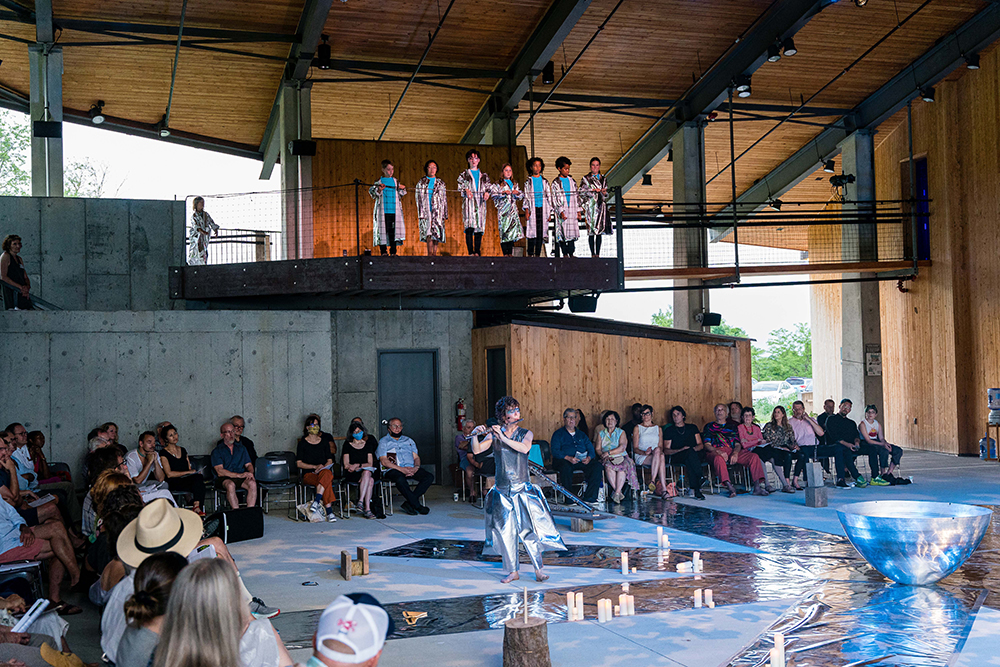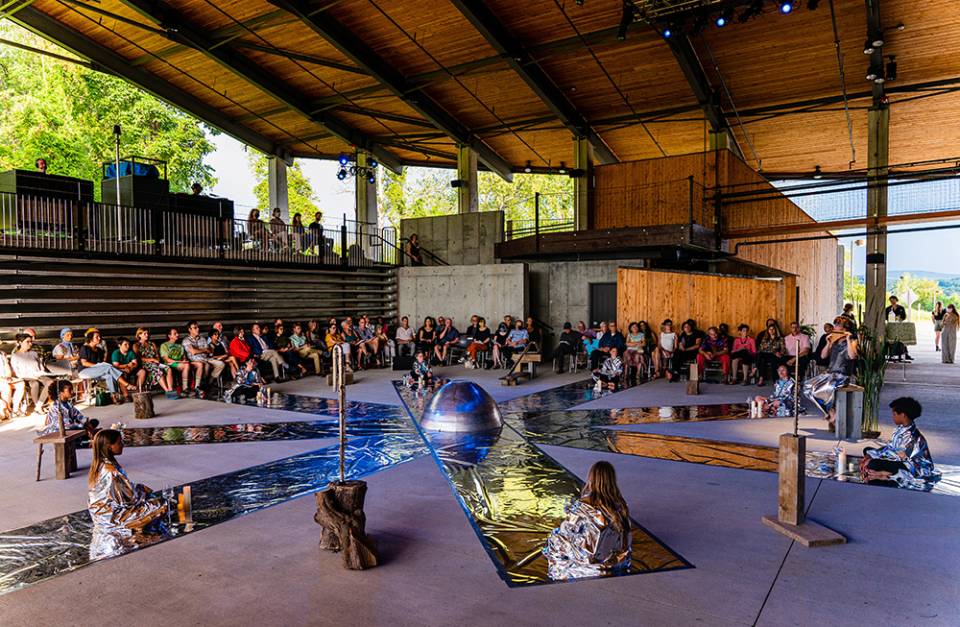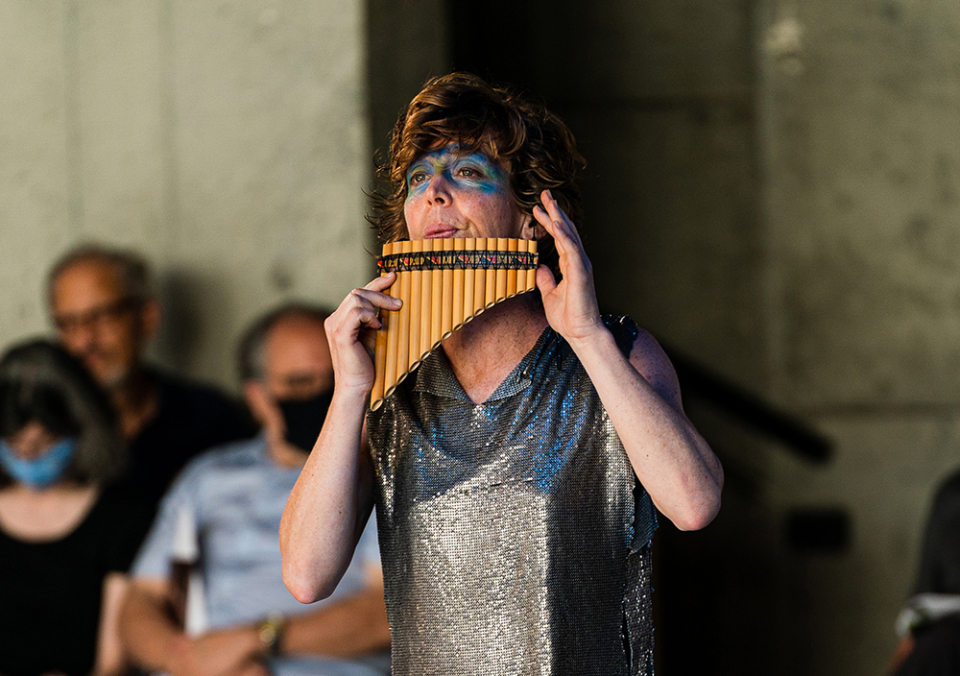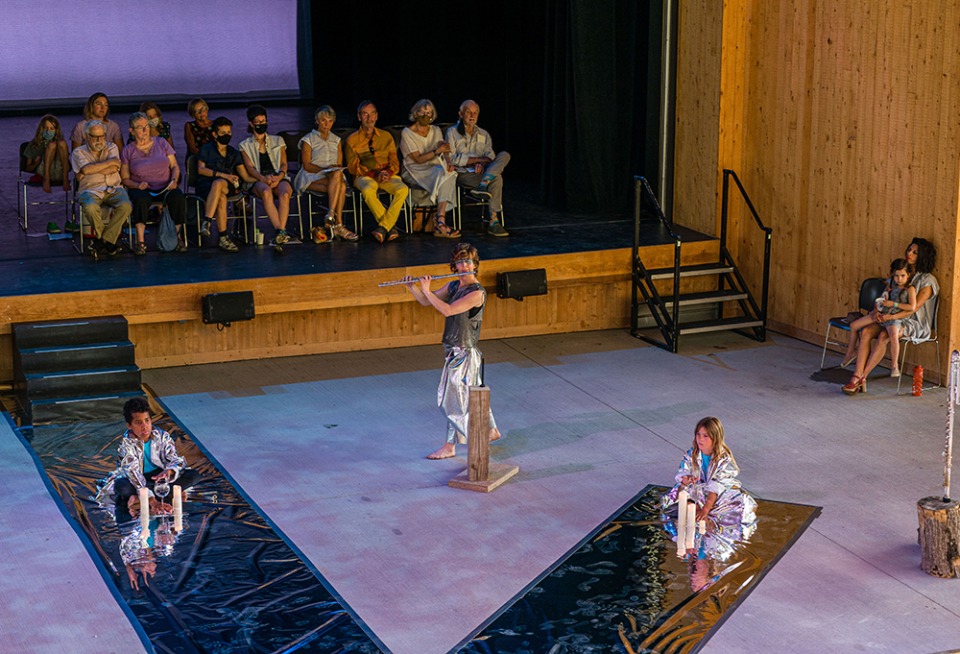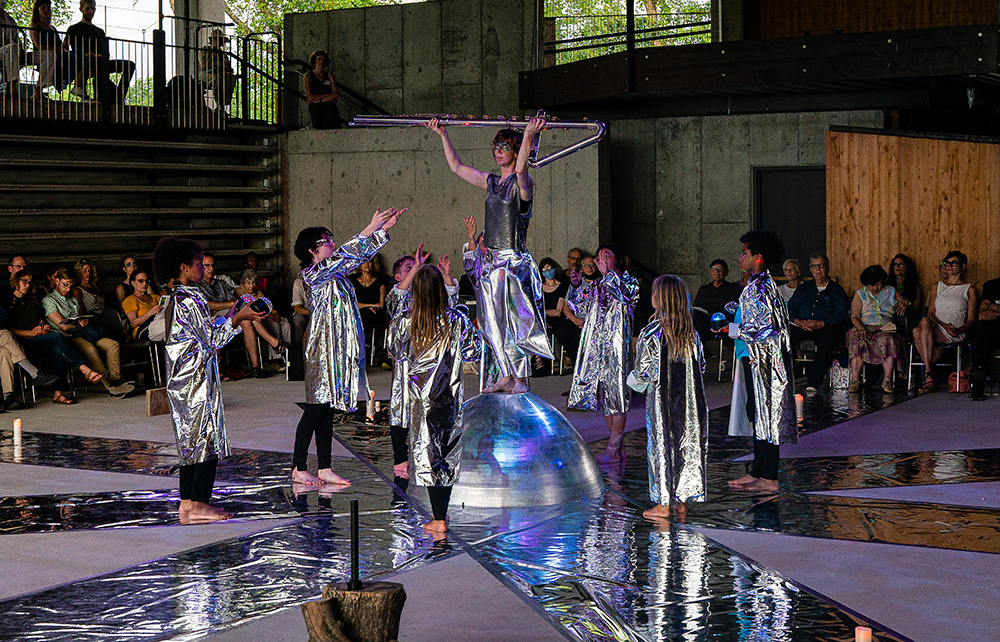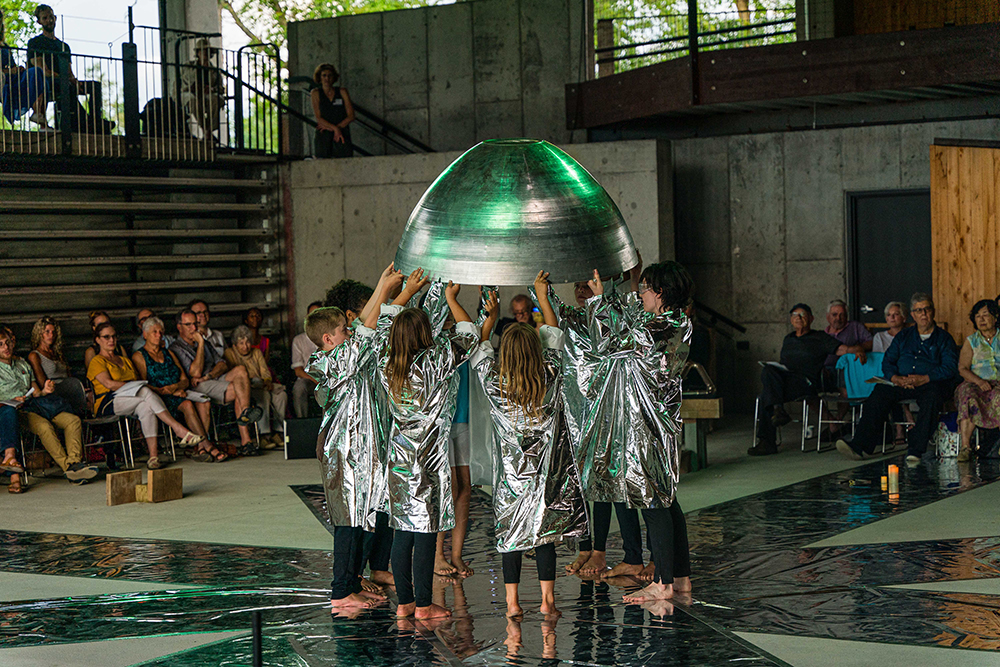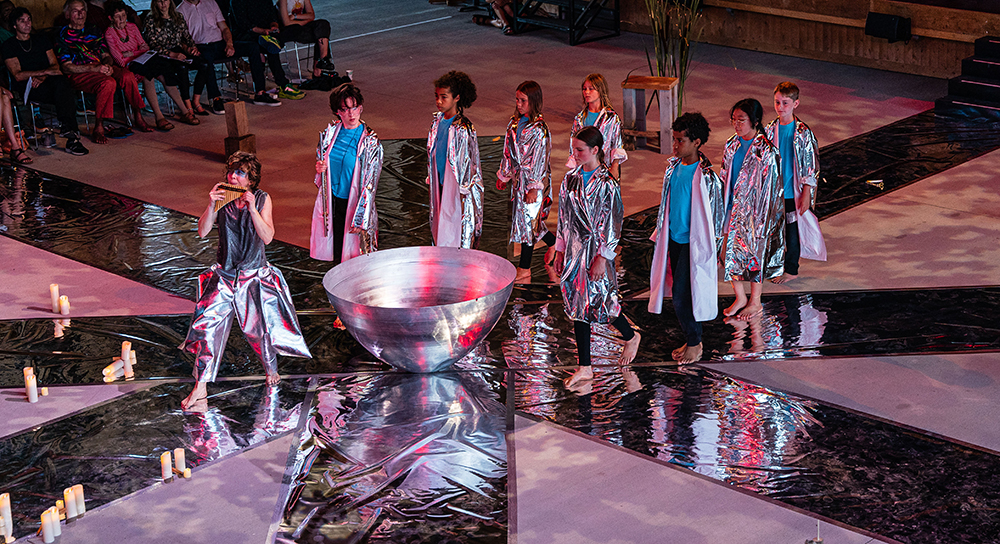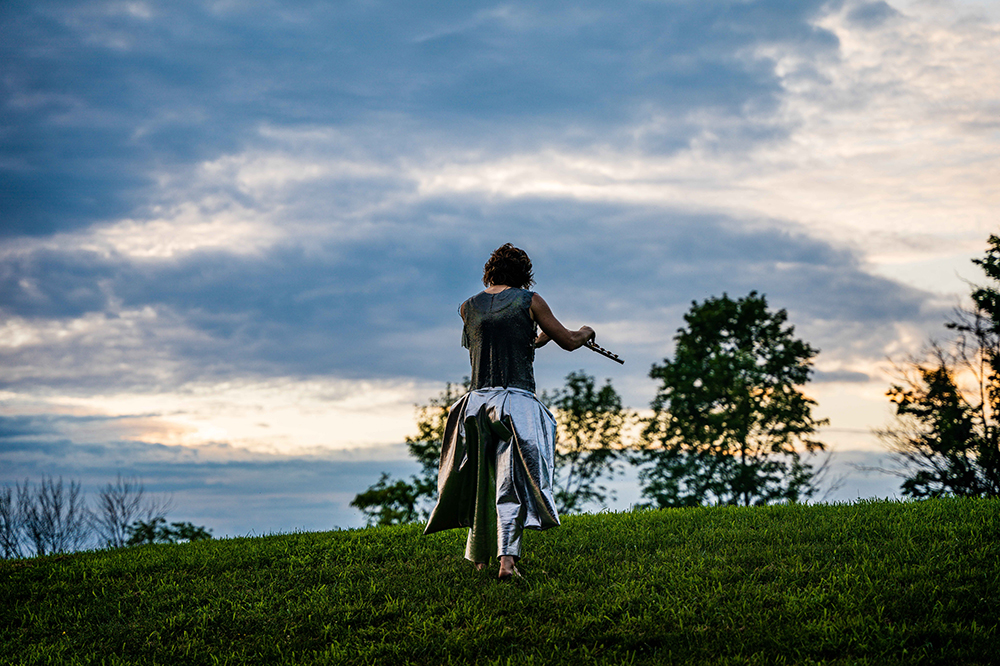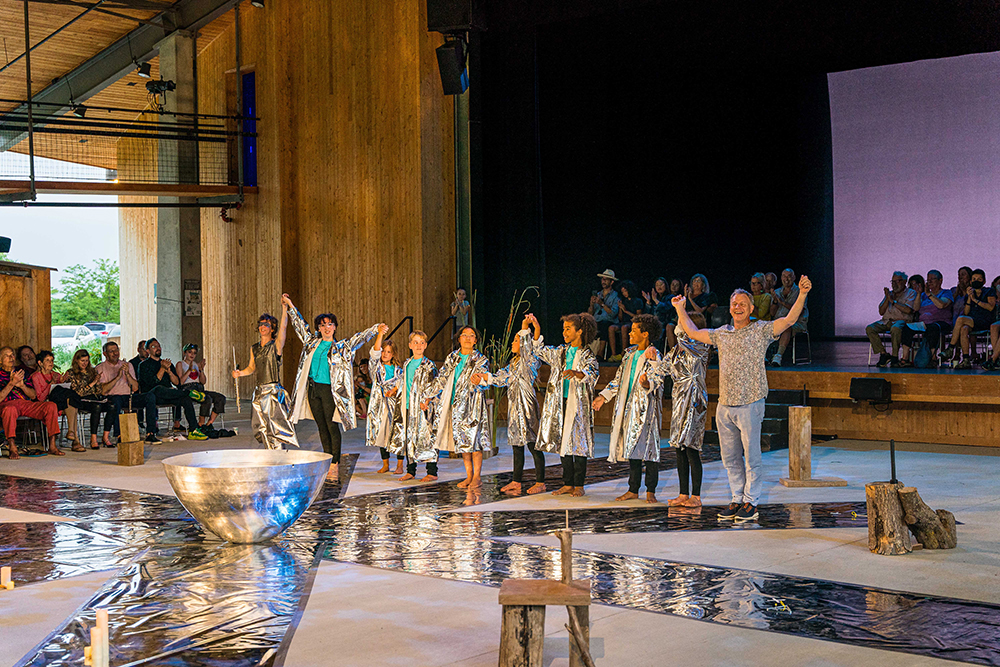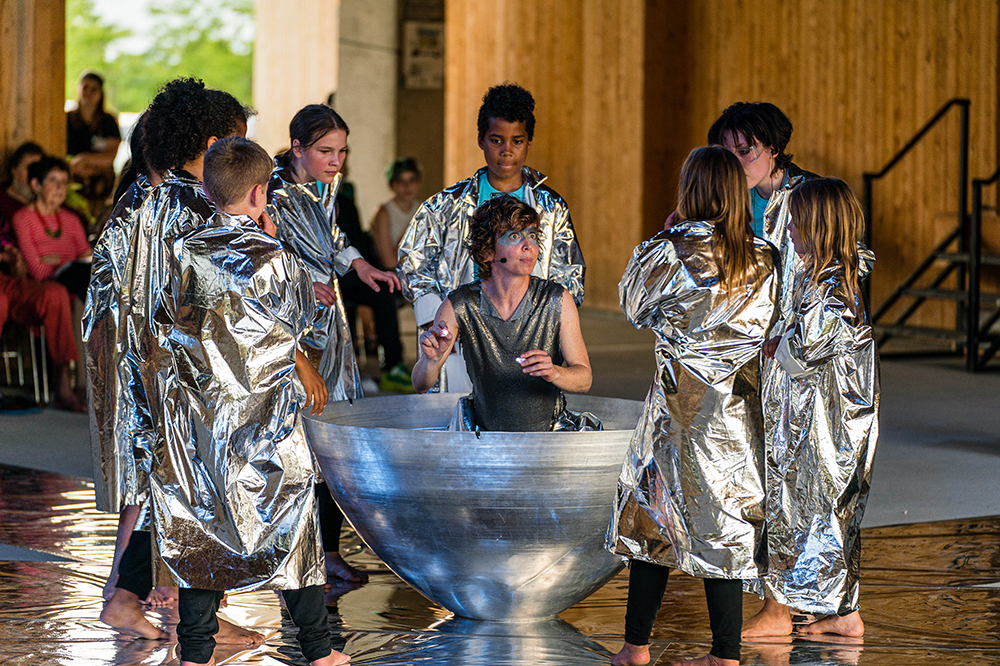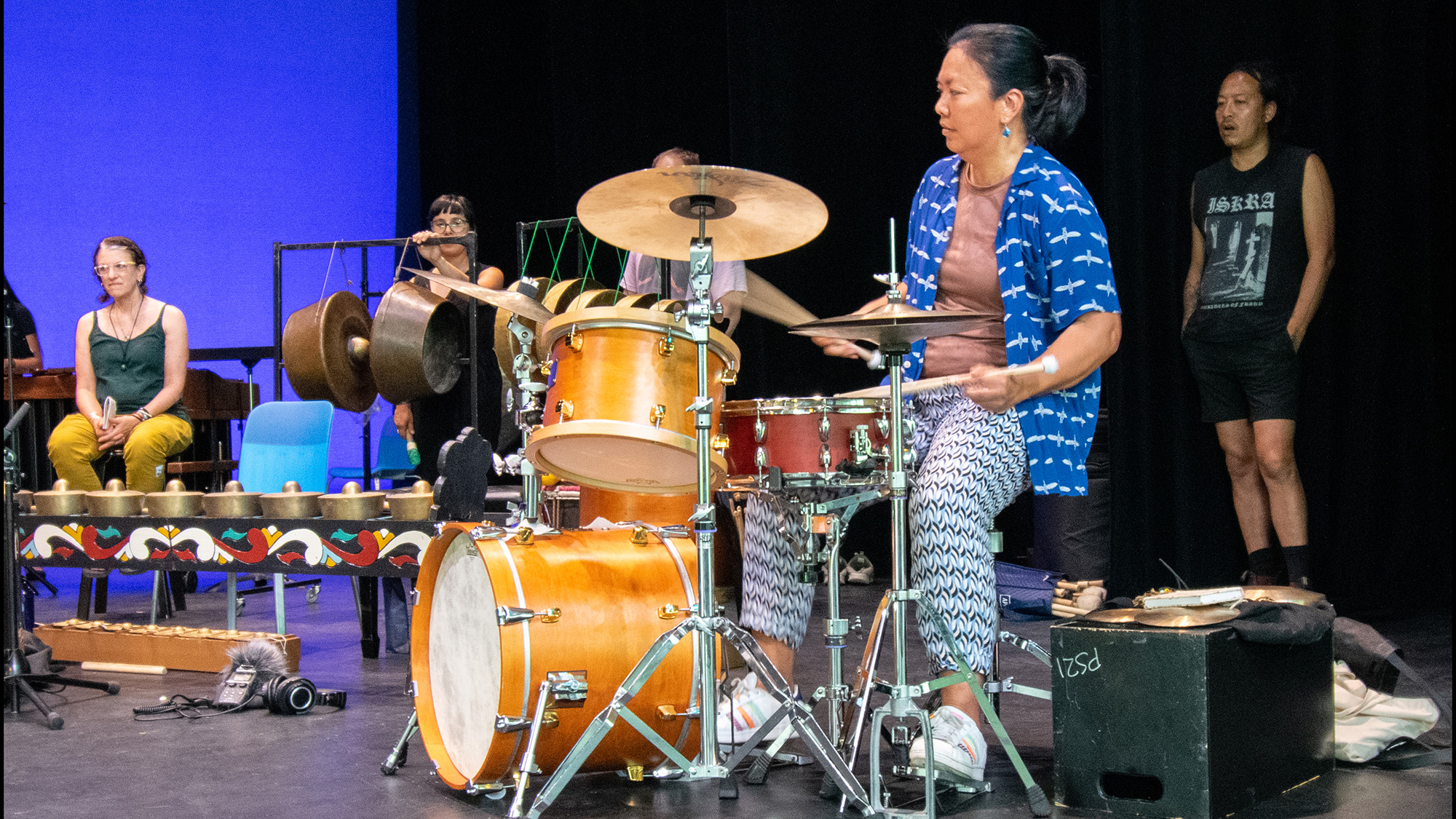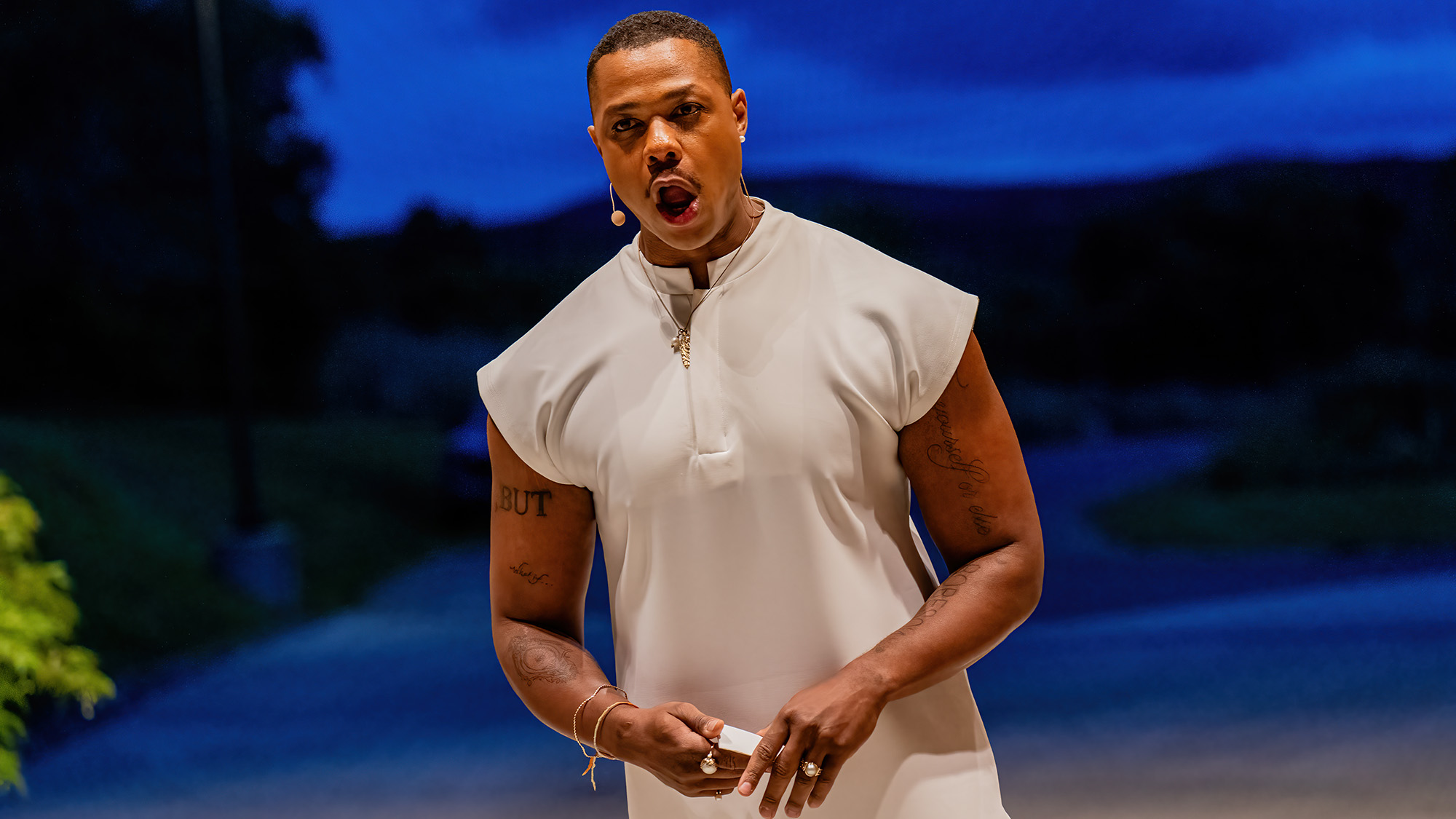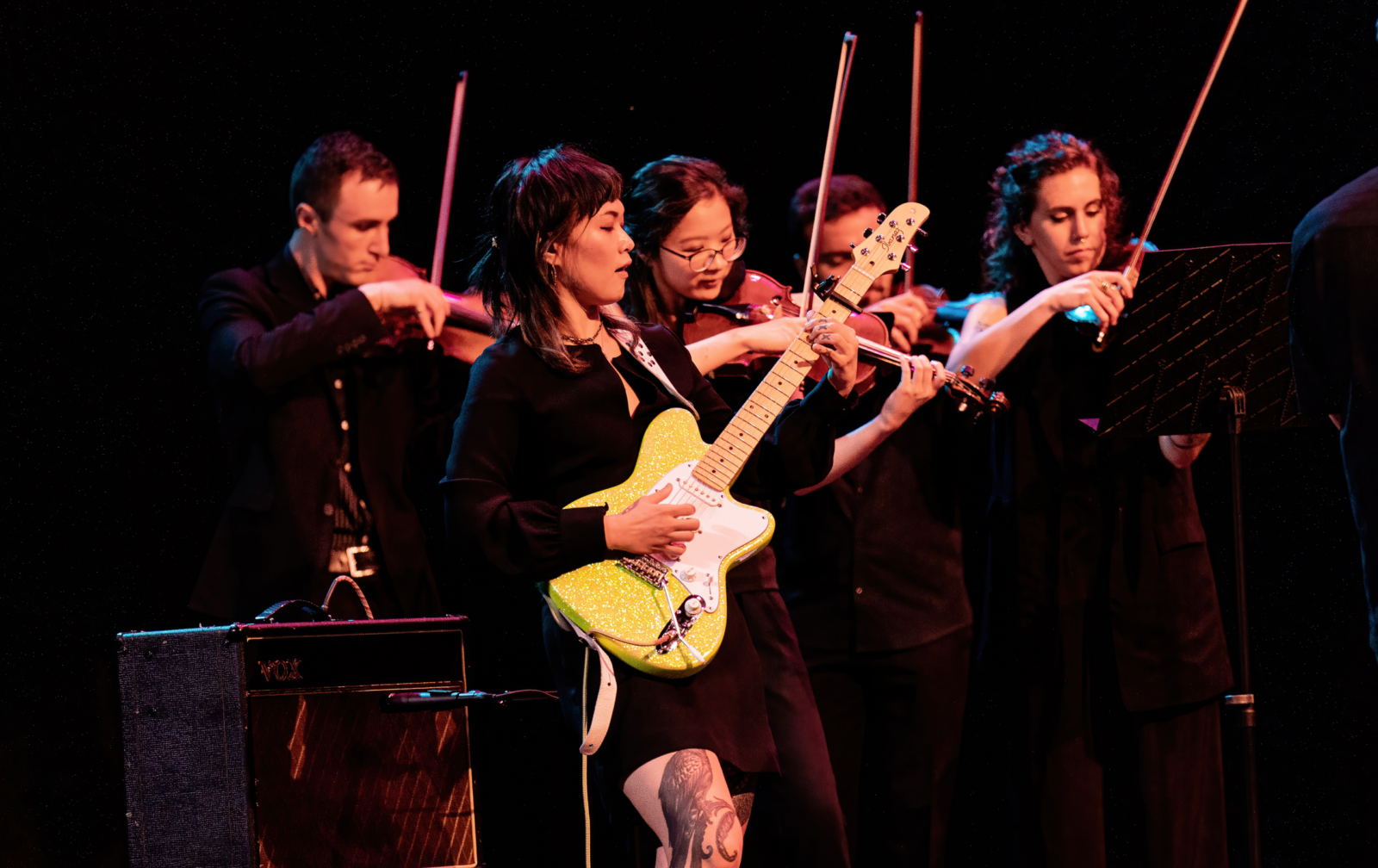
PAN
Claire Chase and Doug Fitch
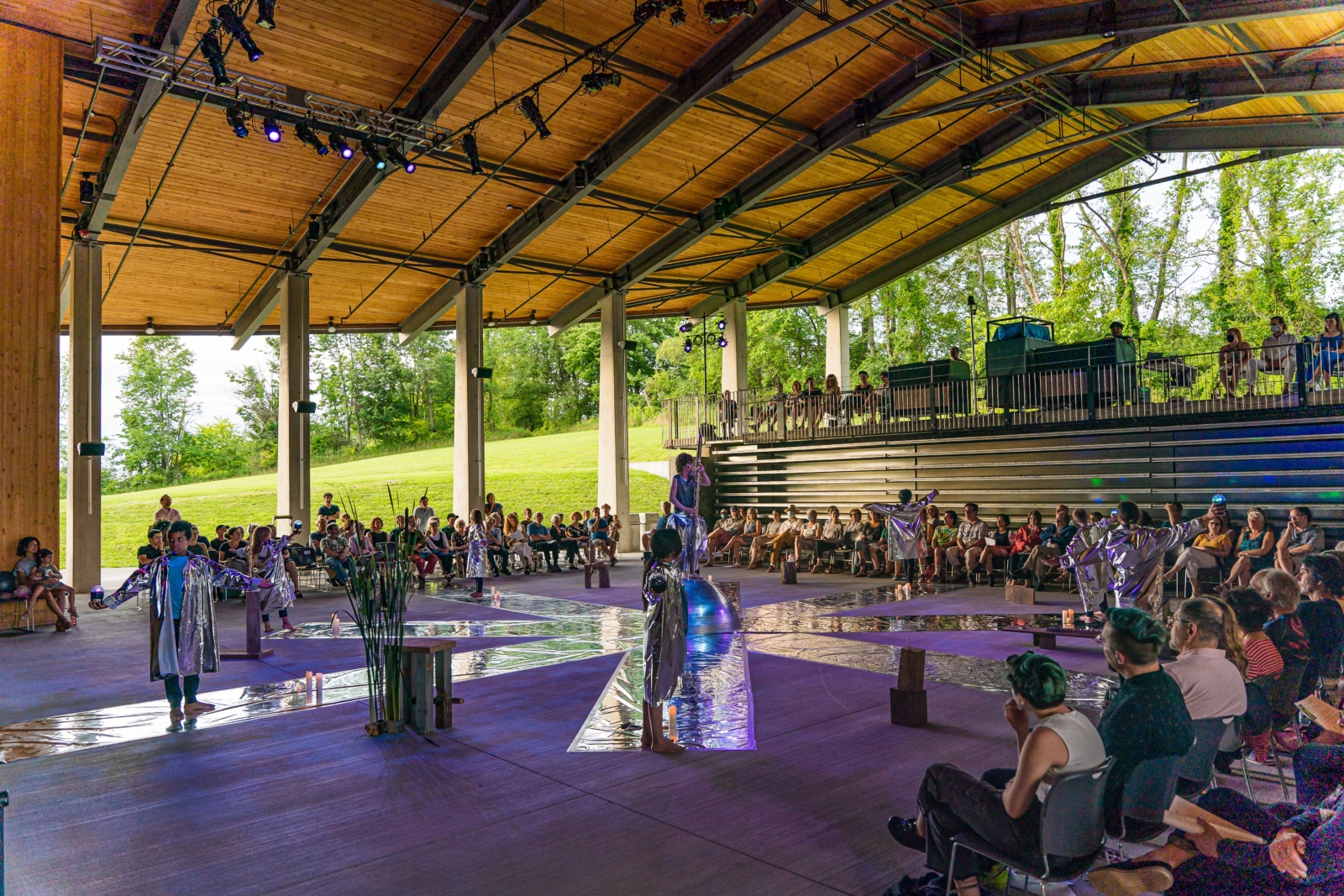
Directed by visual artist and opera director Doug Fitch, Pan, for flutist Claire Chase, a 2012 MacArthur Fellow, and chorus, explores the tensions of today’s experience and community through the myth of the god of rustic music and the only mortal member of the Greek pantheon.
Pan is an evening-length piece for flute, live electronics, and an ensemble of community performers. It tells the story of the mythological goat-god Pan, one of only two Greek deities said to have been put to death, in a series of staged episodes exploring the contradictions and betrayals in Pan’s relationships. Members of the community in which it’s performed are collaborators alongside flutist Claire Chase.
CLAIRE CHASE
Claire Chase, described by The New York Times recently as “the North Star of her instrument’s ever-expanding universe,” is a musician, interdisciplinary artist, and educator. Passionately dedicated to the creation of new ecosystems for the music of our time, Chase has given the world premieres of hundreds of new works by a new generation of artists, and in 2013 launched the 24-year commissioning project Density 2036. Now in its tenth year, Density 2036 reimagines the solo flute literature over a quarter-century through commissions, performances, recordings, education and an accessible archive at density2036.org. Chase co-founded the International Contemporary Ensemble in 2001, was named a MacArthur Fellow in 2012, and in 2017 was awarded the Avery Fisher Prize from Lincoln Center for the Performing Arts. Chase is currently Professor of the Practice of Music at Harvard University’s Department of Music, a Creative Associate at The Juilliard School, and a Collaborative Partner with Esa-Pekka Salonen and the San Francisco Symphony. She is the Debs Creative Chair at Carnegie Hall for the 2022-23 season.
DOUG FITCH
A visual artist, designer, and director, Doug Fitch has created productions for the NY Philharmonic, Los Angeles Opera, Los Angeles Philharmonic, Santa Fe Opera, and Royal Stockholm Philharmonic Orchestra, and for Bard’s SummerScape Festival. He is also a co-founder of Giants Are Small, which, in co-production with Universal Music and Deutsche Grammophon, developed Peter and the Wolf in Hollywood — a digital album featuring Alice Cooper as narrator and the German National Youth Orchestra. Recent highlights include LA Opera’s remount of Hansel and Gretel, Le Grand Macabre at the ElbPhilharmonie in Hamburg, and Punkitititi: a new show commissioned by Rolando Villazon for Mozart Woche 2020 with the Salzburg Marionette Theater, featuring Geoff Sobelle, and Pan, developed in collaboration with composer Marcos Balter and flutist Claire Chase.
As far as ancient societies were concerned, the gods could do no wrong — but not because they were necessarily benevolent. The concepts of sin and wrongdoing simply didn’t apply to divinities: the gods were seen as beyond good and evil entirely, as Nietzsche puts it. And they were beyond mortality too, of course: by definition, the gods could not die.
But things were less clear when it came to the demigods. Take a satyr: an in-between creature, neither god, nor man, nor beast. Could satyrs do wrong? Were they mortal, or not? And if satyrs could sin, and die, would it ever be justifiable to put them to death?
Pan, whose story unfolds over the nine tableaux of ‘Pan’, is the satyr-lord of the woodlands, of shepherds and flocks; he is the protector of groves and the enchanter of all that hear his music. His musical talents are certainly godlike, as are the powers that those talents bring in their train, but Pan is not really a god — or at least, he is not acknowledged as such. When Pan invites Apollo to compete with him in a musical duel, Apollo sees this not as a reasonable challenge between equals, but as an outrage, an offensive display of arrogance by an upstart pretender. Pan is seized, tortured, and in his eventual death Pan gives his persecutors the satisfaction of knowing that they were right to treat him as an outcast: if he has died, he can’t ever have been a true god.
In many ways, Pan is more animal than anything. He has the hindquarters, legs and horns of a goat, and he can be as heedless and vicious as any wild creature. But Pan does not really belong among the animals either — for Pan is on the cusp of becoming human.
‘Pan’ offers a musical portrait of this turbulent transformation. As we listen to the music that Pan plays, noticing how it alters, we are given an insight into what it would be like to be a creature taking the first hesitant steps into the space of reasons, accountability, and love.
The transition from beast to man is not a linear one. Over the course of the work, we hear Pan’s subjectivity veering continually and unpredictably between the animal and the human. At times, we are given his white-hot, right-here-right-now animal consciousness: the searing rage, the overwhelming desire, the single-minded and unalloyed self-interest. But at other times, we sense the dawning of compassion, and a burgeoning need for companionship.
‘Pan’ begins with Pan’s violent death at the hands of Apollo, the horror of which is made viscerally apparent in the musical texture (‘Death of Pan’). As the agony becomes unbearable in his final moments, Pan begins to lose consciousness of the world around him. He turns inward. Pan dwells on his grief for what he has lost (‘Processional’) before he begins to relive the course of events that has terminated in this most hideous of fates.
We are taken back to the very beginning of Pan’s transformation, right back to when he experienced his first glimmers of human feeling. This is the moment of Pan’s twofold discovery: of music on the one hand, and community on the other. As Pan begins to play, we see a community begin to amass around him in the form of the listeners that flock to hear his music (‘Pan’s Flute’).
Pan initially conceives of the community as a convenient means by which he may pursue his own interests, but this begins to change (‘Harmony of the Spheres’), as Pan begins to see his followers as fellow consciousnesses with minds and wills of their own: as people from whom he seeks recognition. As his conception of himself and his companions begins to alter, Pan is approaching the idea of a form of goodness that outstrips self-interest. He begins to feel love. ‘Echo’, ‘Serenade’ and ‘Dance of the Nymphs’ are Pan’s hymns to his three lovers: Echo, Selene and Syrinx.
But a condition of grasping goodness is grasping its converse. And Pan is coming to know what evil is, too. Pan has committed unspeakable acts of violence against all three of his lovers, and he is now beginning to understand what it is that he has done. Pan’s love songs are thus at once tender and nightmarish: love is shot through with horror, guilt and the fear of retribution. ‘Echo’, ‘Serenade’ and ‘Dance of the Nymphs’ thus portray Pan’s first encounters with two of the most distinctively human emotions: love on the one hand, and shame on the other.
These initial encounters come to fruition in the penultimate tableau, ‘Fray – The Unravelling’. Here, for the first time, we realise that Pan isn’t the only one who has been moving toward a clearer conception of himself. His community has, too — and now, Pan’s followers are realising that they can no longer countenance his misdeeds. The musical charm breaks. Pan’s companions turn from him in protest. And for Pan, as for so many of us, the full acknowledgment of his wrongdoing arrives only when he sees the knowledge of it written on the faces of his friends.
It is at this moment — the moment at which Pan’s transgressions are publicly acknowledged in a society of equals, and he is forced to confront the impact that his actions have had on his community — that Pan finally becomes human. He has finally understood love and hatred, sin and redemption, fellowship and betrayal. The transformation of consciousness is complete. Pan offers one last, thoroughly human plea for forgiveness (‘Soliloquy’), but it is too late.
Pan has spent his entire existence as an outcast, shunned by the worlds of god, man and beast alike. At last, in not only grasping but also valuing the core of what it is to be human, he proves himself to be deserving of recognition by, and inclusion in, the world of man. But the very moment at which he does so is the moment of his final, and irrevocable, banishment.
Many works of art explore what it is to be human. But ‘Pan’ explores what it might be like to become human. ‘Pan’ makes it clear that transformation of consciousness from animal to human carries with it not just the possibility of redemption, but the seeds of tragedy, too.
Marcos Balter: Pan (2018, rev. 2020) For flutes, electronics, and a community ensemble
Claire Chase flutes
Levy Lorenzo live sound
Douglas Fitch director
Nicholas Houfek lighting designer and production manager
Sharone Malka costume designer
Taiga Ultan chorus leader
“Greek chorus,” an ensemble of community members
Pan was generously commissioned by Project& and Jane M. Saks, creative producer and collaborator. Pan is the fifth cycle of Claire Chase’s 24-year Density 2036 project. Density 2036: part v (2018) is dedicated to Andreas Waldburg-Wolfegg.
SEE PHOTOS FROM THE PERFORMANCE
